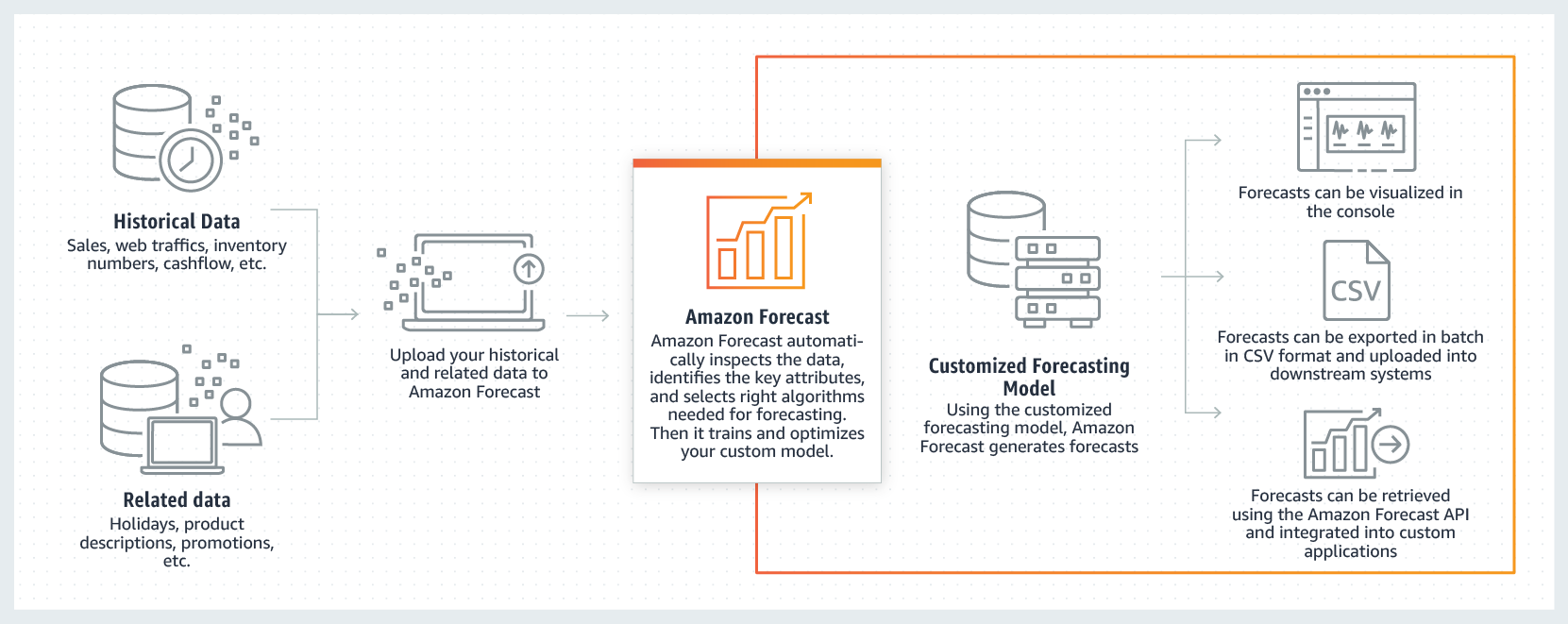Unleashing the Power of AWS Machine Learning: A Forecasting Adventure
 Sumit Mondal
Sumit Mondal
Introduction:
In the vast realm of cloud computing, Amazon Web Services (AWS) stands as a titan, offering a plethora of services that empower businesses to innovate and scale seamlessly. Among the many gems in the AWS arsenal, the machine learning (ML) capabilities have become a game-changer for organizations seeking data-driven insights. In this blog, we embark on a journey into the fascinating world of AWS Machine Learning, with a specific focus on forecasting, a crucial aspect for businesses aiming to stay ahead of the curve.
Understanding AWS Machine Learning:
AWS Machine Learning is a robust suite of services designed to make machine learning accessible to developers and data scientists of all skill levels. Whether you're a seasoned ML practitioner or a novice, AWS has tools and services tailored to meet your needs.
One of the standout features within AWS ML is its forecasting capabilities. Forecasting involves predicting future values based on historical data, and AWS simplifies this complex task by providing a dedicated service aptly named "Amazon Forecast." This service leverages advanced machine learning algorithms to deliver accurate predictions, making it an invaluable asset for businesses in various industries.
Diving into Amazon Forecast:
Let's roll up our sleeves and dive into a hands-on example to showcase the power of Amazon Forecast. For this exercise, let's imagine we're a retail business aiming to predict future sales for a particular product.
Setting Up a Dataset:
First, we need historical data. Assume we have a dataset containing information about past sales, including timestamps, quantities sold, and any relevant factors influencing sales.
Upload this dataset to an Amazon S3 bucket, a scalable and secure storage solution provided by AWS.
Creating a Dataset Group:
In the Amazon Forecast console, create a dataset group and associate it with the S3 bucket containing your data.
Define the frequency of your data, such as daily or hourly, depending on your sales patterns.
Importing Data into Amazon Forecast:
Use the Amazon Forecast console or API to import your historical data into the dataset group.
Amazon Forecast automatically recognizes the timestamp and target values, simplifying the data preparation process.
Choosing an Algorithm:
Select an algorithm that best suits your forecasting needs. Amazon Forecast provides several algorithms, including Prophet, DeepAR+, and CNN-QR.
Each algorithm has its strengths, and you can experiment to see which one performs better for your specific dataset.
Training the Model:
Once you've chosen an algorithm, initiate the training process. Amazon Forecast takes care of the heavy lifting, optimizing the model based on your data.
The trained model learns patterns and trends from the historical data to make accurate predictions.
Generating Forecasts:
After the model is trained, you can use it to generate forecasts for future time periods.
Amazon Forecast provides visualizations and metrics to evaluate the accuracy of your predictions, allowing you to refine and improve the model as needed.
Benefits of Amazon Forecast:
Scalability:
- Amazon Forecast scales seamlessly, accommodating datasets of varying sizes. Whether you're a startup or an enterprise, you can leverage the service without worrying about infrastructure constraints.
Automation:
- The automation provided by Amazon Forecast streamlines the entire forecasting process. From data preparation to model training, much of the manual effort is eliminated, allowing you to focus on interpreting results and making informed decisions.
Accuracy:
- With advanced machine learning algorithms under the hood, Amazon Forecast delivers accurate predictions. The service continually refines its models, ensuring that forecasts remain reliable even as your business evolves.
Customization:
- Amazon Forecast provides the flexibility to fine-tune models based on your specific requirements. You can experiment with different algorithms, hyperparameters, and features to achieve the best results for your use case.
Conclusion:
In this blog, we've embarked on a captivating journey into the realm of AWS Machine Learning, with a particular focus on the forecasting prowess of Amazon Forecast. The hands-on example showcased the simplicity and power of leveraging machine learning for predicting future values based on historical data.
As businesses continue to navigate the ever-changing landscape, the ability to make informed decisions becomes paramount. Amazon Forecast, with its robust capabilities, empowers organizations to harness the potential of machine learning for accurate and insightful forecasting.
In the dynamic world of technology, embracing innovations like AWS Machine Learning is not just a choice; it's a strategic imperative. As we look to the future, the synergy between human intelligence and machine learning promises to reshape industries and drive unprecedented growth. So, let's embrace the possibilities, unlock the potential, and ride the wave of innovation with AWS Machine Learning at our side.
Subscribe to my newsletter
Read articles from Sumit Mondal directly inside your inbox. Subscribe to the newsletter, and don't miss out.
Written by

Sumit Mondal
Sumit Mondal
Hello Hashnode Community! I'm Sumit Mondal, your friendly neighborhood DevOps Engineer on a mission to elevate the world of software development and operations! Join me on Hashnode, and let's code, deploy, and innovate our way to success! Together, we'll shape the future of DevOps one commit at a time. #DevOps #Automation #ContinuousDelivery #HashnodeHero